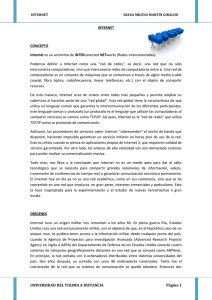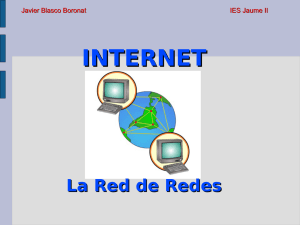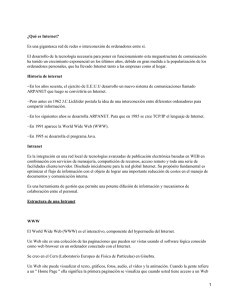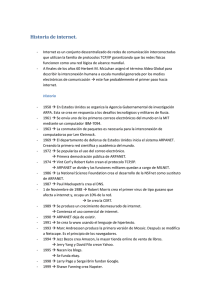Introducción histórica a Internet
Anuncio
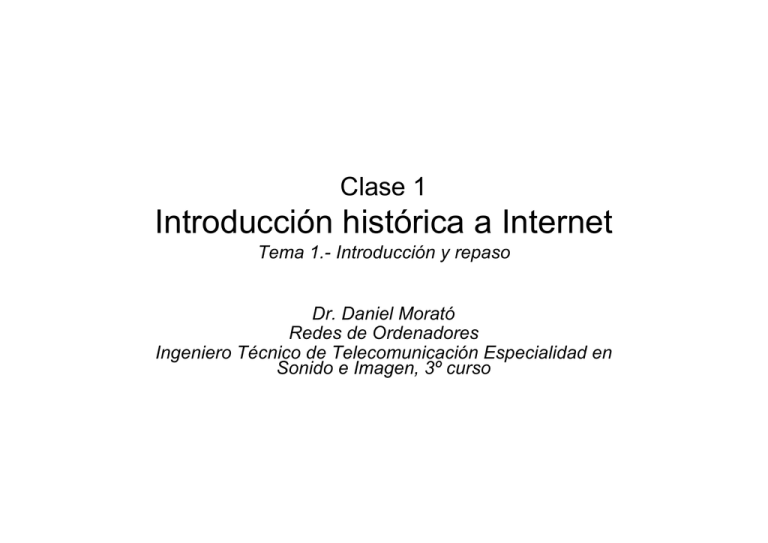
Clase 1 Introducción histórica a Internet Tema 1.- Introducción y repaso Dr. Daniel Morató Redes de Ordenadores Ingeniero Técnico de Telecomunicación Especialidad en Sonido e Imagen, 3º curso Temario 1.- Introducción 2.- Nivel de enlace en LANs 3.- Interconexión de redes IP 4.- Enrutamiento con IP 5.- Nivel de transporte en Internet 6.- Nivel de aplicación en Internet 7.- Ampliación de temas Introducción histórica 1 Temario 1.- Introducción • Introducción histórica a Internet • Repaso de conceptos 2.- Nivel de enlace en LANs 3.- Interconexión de redes IP 4.- Enrutamiento con IP 5.- Nivel de transporte en Internet 6.- Nivel de aplicación en Internet 7.- Ampliación de temas Introducción histórica 2 Contenido • Introducción histórica • Evolución de Internet • Organizaciones y estándares Introducción histórica 3 ¿Qué es Internet? • • • “The Largest network of networks in the world.” “Uses TCP/IP protocols and packet switching.” “Runs on any communications substrate.” Dr. Vinton Cerf Co-Creador de TCP/IP Introducción histórica 4 ¿Qué ofrece? • “…the goal is connectivity, the tool is the Internet Protocol, and the intelligence is end to end rather than hidden in the network.” RFC 1958 Introducción histórica 5 Introducción histórica 1961 Leonard Kleinrock publica el primer artículo sobre conmutación de paquetes 1968 1969 1970 Proyecto ARPA para crear la ARPANET. IMPs primeros nodos ARPANET, 4 nodos (BBN) Líneas de 50Kbps RFCs 1970 SRI UTAH UCSB MIT UCLA BBN UCSB SRI [Kleinrock]: We set up a telephone connection between us and the guys at SRI... We typed the L and we asked on the phone, UCLA: Do you see the L? SRI: Yes, we see the L [Kleinrock]: We typed the O, and we asked UCLA: Do you see the O? SRI: Yes, we see the O [Kleinrock]: Then we typed the G, and the system crashed... Sept. 1972 ARPANET se extiende por EE.UU. 1971 UTAH Illinois MIT Lincoln CASE STAN UCLA 1972 UTAH UCSB SDC UCLA RAND 1971 1969 SRI CARN SDC RAND BBN Harvard Burroughs 35 nodos. Primer e-mail (@!) Introducción histórica 6 Introducción histórica 1973 1974 Conexión con Europa (Univ. College of London) Tesis doctoral de Bob Metcalfe propone Ethernet ARPA => DARPA Nuevos proyectos: Packet Radio, Satelite. Necesidad de interconectar diferentes tecnologías. TCP (Robert Kahn+Vint Cerf) 1978 TCP supone mucha carga para los routers. TCP => IP + TCP 1979 ARPANET tiene 200 nodos 1980 Un nuevo host cada 20 días 1982 TCP/IP estándar del DoD 1983 El tráfico de datos militar de ARPANET se separa a MILNET Interconectadas gracias a IP (completada la transición a TCP/IP) 4.2 BSD (Sockets) 1986 La NSF financia la NSFNET para centros de investigación. Enlaces 56Kbps Introducción histórica 7 Introducción histórica 1988 1989 1990 La NSFNET promueve sus enlaces a T1s (1.544Mbps) Intento de cambiar de TCP/IP a los protocolos OSI Debido a un gusano (worm) Internet queda detenida Nace la “Web” (Tim Berners-Lee, CERN) 100.000 máquinas en la red La ARPANET se ha ido haciendo más pequeña y desaparece La NSFNET es el nuevo backbone 1991 La NSFNET promueve sus enlaces a T3 (44.736Mbps) y permire la conexión de redes comerciales 1992 Se funda la ISOC 1993 La NSF deja de fundar redes. Internet comercial 19.000 redes Mosaic 1994 Decisión de no cambiar a OSI 1995 NSFNET “decomissioned”. Intenet comercial. 50.000 redes Introducción histórica 8 Evolución de Internet • • • • • • • • 1977: 111 hosts 1981: 213 hosts 1983: 562 hosts 1984: 1.000 hosts 1986: 5.000 hosts 1987: 10.000 hosts 1989: 100.000 hosts 1992: 1.000.000 hosts Introducción histórica 9 Evolución de Internet (Enero 2000) Introducción histórica 10 Evolución de Internet (Agosto 2001) Introducción histórica 11 Evolución de Internet (Abril 2002) Introducción histórica 12 Evolución de Internet (Abril 2003) Introducción histórica 13 Ejemplo: RedIRIS Introducción histórica 14 Conectividad de RedIRIS STM-64 STM-4 GigaEthernet FastEthernet Introducción histórica 15 GEANT Introducción histórica 16 Conectividad global de GEANT Introducción histórica 17 Red de WorldCom en el 2002 Introducción histórica 18 Global Crossing Corporation Introducción histórica 19 Williams Communications Introducción histórica 20 Teleglobe (1999) etc... Introducción histórica 21 Algunas organizaciones • IETF: Internet Engineering Task Force (www.ietf.org) “... is a loosely self-organized group of people who contribute to the engineering and evolution of Internet technologies. It is the principal body engaged in the development of new Internet standard specifications.” [RFC3160] • ISOC: Internet Society. Sin ánimo de gubernamental ni técnico (www.isoc.org) lucro. No “The Internet SOCiety (ISOC) is a professional membership society with more than 150 organization and 16,000 individual members in over 180 countries. It provides leadership in addressing issues that confront the future of the Internet, and is the organization home for the groups responsible for Internet infrastructure standards” [RFC3160] • IESG: Internet (www.ietf.org/iesg.html) Engineering Sterring Group “ ... The IESG ratifies or corrects the output from the IETF's Working Groups, gets WGs started and finished, and makes sure that non-WG drafts that are about to become RFCs are correct.” [RFC3160] • IAB: Internet Architecture Board (www.iab.org) “The IAB is responsible for keeping an eye on the "big picture" of the Internet, and focuses on long-range planning and coordination among the various areas of IETF activity.” [RFC3160] Introducción histórica 22 Organizaciones y estándares • • • • • IANA: Internet Assigned Number Authority (www.iana.org) ICANN: Internet Corporation for Assigned Names and Numbers (www.icann.org) IRTF: Internet Research Task Force (www.irtf.org) RFC: Request For Comments (www.rfc-editor.org) Drafts, STDs, FYIs, BCPs Internet Society IAB IRTF “the IETF” IESG IANA IANA RFC area area area Jon Postel 6/8/1943-16/10/1998 “Be liberal in what you accept and conservative in what you send” [RFC760] Editor de los RFC durante 30 años We reject kings, presidents and voting. We b elieve in rough consensus and running code. Dave Clark [MIT] Introducción histórica 23 Resumen • • • • • Internet es Joven Hoy en día es la red de ordenadores Compuesta por la interconexión de numerosas redes TCP/IP es la familia de protocolos que emplea Proviene del ámbito de la investigación, no de la empresa • Estándares de facto Introducción histórica 24 Temario 1.- Introducción • Introducción histórica a Internet • Repaso de conceptos 2.- Nivel de enlace en LANs 3.- Interconexión de redes IP 4.- Enrutamiento con IP 5.- Nivel de transporte en Internet 6.- Nivel de aplicación en Internet 7.- Ampliación de temas Introducción histórica 25 Próxima clase Repaso de conceptos • Lecturas: – [Kurose05] 1.1-1.2, 1.3.1-1.3.2 – [Forouzan03] 2.1-2.2 – 37 páginas Introducción histórica 26
